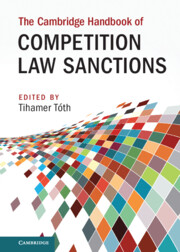Book contents
- The Cambridge Handbook of Competition Law Sanctions
- The Cambridge Handbook of Competition Law Sanctions
- Copyright page
- Contents
- Authors’ Affiliations
- Acknowledgment
- Part I General Chapters
- Part II Country Reports
- 17 Competition Law Sanctions in Austria
- 18 Antitrust Enforcement in Belgium
- 19 The Effectiveness of Competition Law Sanctions: Brazil
- 20 The Present Situation and Improvement Direction of the Sanction System in China’s Anti-monopoly Law
- 21 Application of the 2006 Guidelines on Fines by the European Commission and the Union Courts
- 22 Competition Law Sanctions in Germany
- 23 Competition Law Sanctions in Hungary
- 24 Competition Law Sanctions in Indonesia and a Comparison to Other ASEAN Member States
- 25 Competition Law Sanctions in Italy
- 26 Competition Law Sanctions in Japan
- 27 Effectiveness of Competition Law Sanctions: Kenya
- 28 The Enforcement of Competition Law in the Netherlands
- 29 A Barking Dog Seldom Bites
- 30 Effectiveness of Competition Law Sanctions
- 31 Competition Law Sanctions in Spain
- 32 The Swedish Competition Law Enforcement System
- 33 Effectiveness of Competition Law Sanctions: Turkey
- 34 Competition Law Sanctions in the United Kingdom
20 - The Present Situation and Improvement Direction of the Sanction System in China’s Anti-monopoly Law
from Part II - Country Reports
Published online by Cambridge University Press: 29 July 2022
- The Cambridge Handbook of Competition Law Sanctions
- The Cambridge Handbook of Competition Law Sanctions
- Copyright page
- Contents
- Authors’ Affiliations
- Acknowledgment
- Part I General Chapters
- Part II Country Reports
- 17 Competition Law Sanctions in Austria
- 18 Antitrust Enforcement in Belgium
- 19 The Effectiveness of Competition Law Sanctions: Brazil
- 20 The Present Situation and Improvement Direction of the Sanction System in China’s Anti-monopoly Law
- 21 Application of the 2006 Guidelines on Fines by the European Commission and the Union Courts
- 22 Competition Law Sanctions in Germany
- 23 Competition Law Sanctions in Hungary
- 24 Competition Law Sanctions in Indonesia and a Comparison to Other ASEAN Member States
- 25 Competition Law Sanctions in Italy
- 26 Competition Law Sanctions in Japan
- 27 Effectiveness of Competition Law Sanctions: Kenya
- 28 The Enforcement of Competition Law in the Netherlands
- 29 A Barking Dog Seldom Bites
- 30 Effectiveness of Competition Law Sanctions
- 31 Competition Law Sanctions in Spain
- 32 The Swedish Competition Law Enforcement System
- 33 Effectiveness of Competition Law Sanctions: Turkey
- 34 Competition Law Sanctions in the United Kingdom
Summary
The sanction system of China’s anti-monopoly law mainly comprises administrative penalty and civil damages compensation, with administrative penalty as the core sanction method. The mode of administrative penalty combining confiscation of illegal income and fines established in the Anti-monopoly Law is not ideal in practice. Confiscation of illegal income is often absent, which greatly affects the deterrent capacity of anti-monopoly sanctions. At the same time, imposing fines is not a sufficient deterrent on its own. To solve the predicament, in the revision of the Anti-Monopoly Law it is proposed to cancel confiscation of illegal income and learn from the internationally mainstream anti-monopoly administrative punishment mode by integrating the function of confiscation of illegal income in the form of fines, that is, replacing it with the fines-oriented anti-monopoly administrative punishment model, in order to make punishment more certain. In addition, China should reform the anti-monopoly law fine system in order to increase deterrence, including clarifying the meaning of “sales”, abolishing minimum fines of 1%, and considering civil damages as a mitigating factor for fines.
Keywords
- Type
- Chapter
- Information
- The Cambridge Handbook of Competition Law Sanctions , pp. 355 - 366Publisher: Cambridge University PressPrint publication year: 2022

